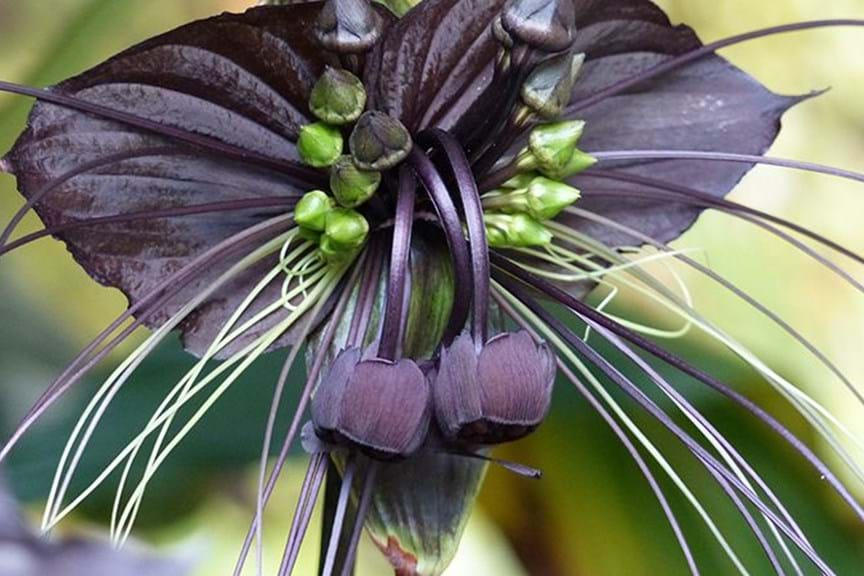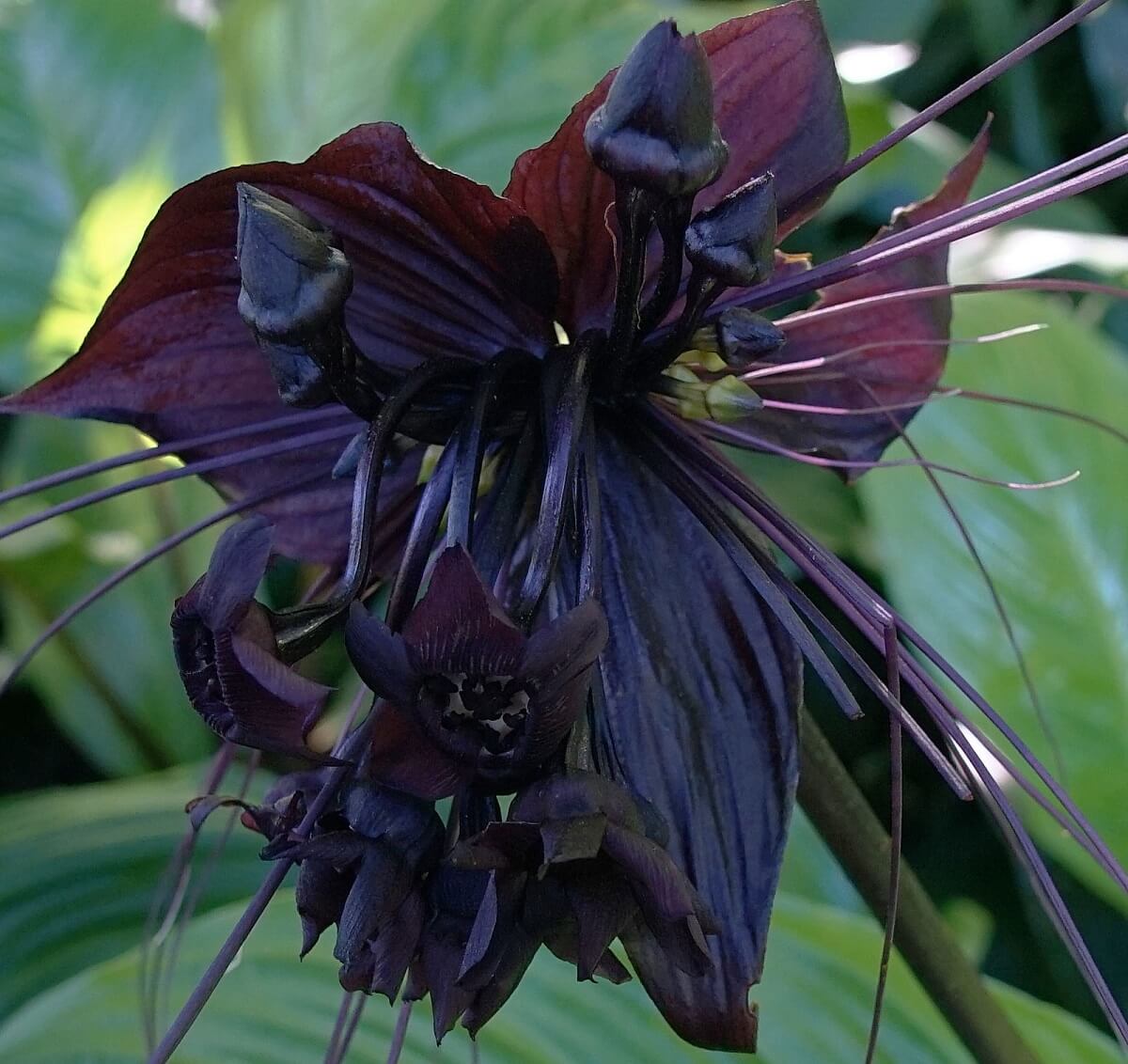“What is that?” I exclaimed, pointing at the black thing that sat atop a tall stem. “Black thing” was the best way I could describe it, though perhaps some avid gardeners would refer to it as deep purple. Not me! It definitely was black. With two wide flower petals flattened back like wings around what looked like whiskers, the “black thing” looked strangely like a bat instead of a flower. I hated bats. I know they serve their purpose, but growing up in a haunted house full of ghosts and bats, I wasn’t one to enjoy their presence. Let alone enjoy a flower that looked like a bat.
Surprisingly, or not so much, my friend informed me, “It’s a bat flower.” Noticing my look of disbelief, she smiled knowingly and said, “Really. It’s a black bat flower. Tacca chantrieri if you want to get really technical.”
I suppose I shouldn’t be surprised to find a bat flower in my friend’s garden. She loved Halloween and everything that spookily looked like Halloween. But it was a long time until Halloween, and here was this spookily, bat-look-alike thing growing in her garden.
“It’s like an orchid,” she added. I wasn’t so sure. A flower called a bat? And one that actually looked like a bat? I had to admit, it was unusual. Not one I would choose for my garden. But it certainly would make a good conversation piece. And I was even more skeptical that it was “like an orchid,” as my friend explained.
I looked closer, studying the black bracts (which are really leaves, though they resemble flower petals) that stretched out, eerily, like bat wings. Indeed, the entire flower was somewhat bat-shaped. The bracts stretched out to almost 12 inches across, like the wings of a bat in flight. And there were long whiskers, thread-like bracteoles, about 8 inches long, poking out of the center ovule, just below the stigma. Very bizarre.
I moved away from the bat flower and decided to do my own research later. Which I did. I discovered a wealth of information. The genus, Tacca, of which Tacca chantrieri (or black bat flower) belongs, has 10 species, including Tacca integrifolia, or a white bat flower.
The flower looks the same except for the coloring. The white bat flower has white bracts with purple veins, and it’s larger than the black bat flower. Quite a bit larger, actually, as it can grow up to 4 feet tall, almost twice the size of the black bat flower which only grows up 1-3 feet tall.
The coloring of the black bat flower also varies. It may be black (hence the name), dark purple or even maroon, bronze, brown and green.
The unique and intriguing bat plant, also known as devil flower or tacca chantrieri, is gaining popularity among gardeners and plant enthusiasts. Native to Southeast Asia, this tropical plant is known for its bat-shaped flowers and ease of care.
One common question that arises when growing a bat plant is – how tall can it grow? The maximum height of a bat plant depends on several key factors. In this comprehensive guide, we will explore the factors that affect the height of bat plants to help you understand their growth potential.
Genetics Play a Role
Like humans, plants inherit their traits from parent plants. If your bat plant has tall parentage, there is a high likelihood it will also grow tall. However, genetics alone don’t determine height. Environmental factors also play a significant role.
Ideal Growing Conditions Are Critical
To reach their maximum height potential bat plants need optimal growing conditions
Lighting
Bat plants need bright but indirect light to thrive Insufficient light can result in stunted growth Place them near a south or west facing window.
Temperature
Ideal temperatures are 65°F to 80°F (18°C to 27°C). Below 60°F (16°C), growth may slow or stop altogether. Maintain indoor temperatures above 60°F.
Humidity
Humidity should be 50% or higher. Below 50% humidity, leaf edges may turn brown and curl. Increase humidity by misting plants daily or using a humidifier.
Soil
Well-draining, organic rich soil is ideal. Soil that is too dense or sandy can restrict growth. Amend soil with compost to improve drainage.
Fertilizer
Regular fertilization provides vital nutrients for growth. Use a balanced liquid fertilizer every 2-4 weeks during spring and summer.
Water
Water when the top inch of soil is dry. Ensure soil drains well to prevent root rot from overwatering.
Pot Size Matters
The size of pot used can impact maximum height. A too-small pot restricts growth as roots become bound. Overly large pots may stunt growth as the plant focuses on root over foliage growth. Re-pot in a slightly larger pot each spring.
Tips for Growing Tall Bat Plants
Follow these tips to maximize the height potential of your bat plant:
-
Place in bright, indirect light near a west or south facing window. Rotate occasionally for even growth.
-
Maintain temperatures between 65°F to 80°F (18°C to 27°C). Keep above 60°F in winter.
-
Increase humidity levels to 50% or above by misting and using a humidifier.
-
Use a well-draining organic rich potting mix. Amend dense soil with compost.
-
Fertilize every 2-4 weeks during spring and summer with a balanced liquid fertilizer.
-
Water when the top inch of soil is dry. Ensure excellent drainage.
-
Repot annually in spring, sizing up only one pot width each time.
Expected Maximum Height
With ideal growing conditions, most bat plant varieties can reach heights of 2 to 3 feet tall (60 to 90 cm). Some key factors that affect maximum height include:
-
Genetics: Plants from taller parentage tend to grow taller.
-
Light: Insufficient light leads to stunted growth.
-
Temperature: Cool temps below 60°F hinder growth.
-
Humidity: Levels below 50% reduce growth rate.
-
Soil: Poorly draining soil restricts growth.
-
Fertilizer: Lack of nutrients causes stunted growth.
-
Pot size: Too small pots restrict growth.
By optimizing these key factors, your bat plant can thrive and reach its maximum height potential of 2 to 3 feet tall!
Common Questions
Here are answers to some frequently asked questions about bat plant height:
How often should I prune my bat plant?
Prune during the active growing season to maintain shape and encourage bushy growth. Avoid excessive pruning.
What causes brown leaf edges?
This is usually due to low humidity. Increase misting and use a humidifier to boost humidity levels.
What temperature is too cold for a bat plant?
Don’t allow temperatures to drop below 60°F, as growth will be stunted. Move to a warmer location in winter if needed.
How much light does a bat plant need?
Bat plants need bright, indirect sunlight for 4-6 hours daily. Insufficient light leads to reduced growth.
How do I encourage more flowers?
Fertilize regularly and provide ideal growing conditions to maximize blooms. Prune after flowering to encourage new growth.
Achieve Maximum Bat Plant Height
By providing optimal care and growing conditions, most bat plant varieties can achieve heights of 2 to 3 feet tall. Maximize their growth potential by giving them plenty of bright, indirect light, warmth, humidity, fertile soil, proper pot size, and regular feeding. With the right environment and care, you can enjoy your bat plant at its full height.

Caring For Bat Flowers
Bat flowers don’t attract pests, other than the usual, bothersome snails and slugs, and there are no known ailments that affect their well-being. However, if grown indoors in a pot, they can suffer the same ailment as orchids: becoming root-bound. This will stunt its growth, and the leaves will wither and die (if they grow at all).
Fertilize the bat flower with an orchid fertilizer bi-weekly and mist it when watering. Should it show signs of being root-bound, repot it with fresh soil, after the flowers have dropped off. It’s usually a good idea to repot bat flowers in fresh soil every year.
Bat Flower Growing Conditions
Native to the tropical regions of southeast Asia—Thailand, Malaysia, and southern China—the bat flower does well in hot, humid climates like Florida. They don’t do well in greenhouses due to the lack of air circulation (they appreciate a little bit of a breeze), and they don’t like the direct sun, preferring at least 60 percent shade.

Like orchids, bat flowers prefer well-drained soil with good air circulation, high humidity and lots of water. Also, like orchids, the flowers should be left on the stem to decline and drop naturally. Bat flowers do not appreciate being cut off the plant, and they won’t survive in a cut-flower arrangement. Best to leave it in the garden as a conversation piece. It is, after all, a collector’s plant. Due to its many unique qualities, it is often difficult to find in garden centers. So, if you have one, treasure it.
Propagation isn’t difficult, but it does take time and patience. Bat flowers can be propagated by dividing the rhizome and tuber or by collecting the seed. You have to watch carefully for the seeds. You don’t want to harvest seeds too soon. Healthy seeds will only appear when the seed-filled capsule matures naturally and splits while still on the plant.
Related Post: 15 Seeds You Should Save
This could take up to 18 months. And germination of the collected seed may last nearly 12 months. Dividing the rhizome and tuber is best done in the early spring when repotting before it starts its growing season.https://www.instagram.com/p/BpFgwR8F1jF/
The mature bat flower will bloom after it has produced at least two leaves. Once it blooms, it will repeatedly bloom up to eight times in a season, producing six to 12 flower stems during its growing period. It usually blooms from late spring to early fall. If you live in a northern growing zone, it can be successfully grown indoors, as long as the place where you try to grow the bat flower has plenty of air circulation and not too much sunlight.
